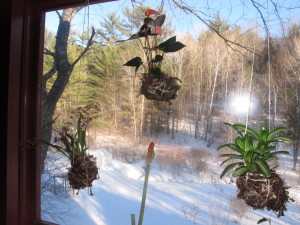A New Way to Grow and Display Indoor Plants: Kokebana
This is the time of year when I am chomping at the bit, all ready to garden, but without much I can do outside. So I was delighted to visit a friend in Maine who was experimenting with a new art form/planting technique: kokebana. This is a Japanese technique for hanging plants indoors – without using pots of any sort of pot, instead wrapping them with moss and strings.

Doing some online research I found that kokebana is also called kokedama, which means ”moss ball” in Japanese. I made three plants into kokebana plants, and it was a great, messy project that made me feel like I was a kid making mud pies. Not bad for a mudseason afternoon.
Kokebana is most successful if you choose small epiphytic plants – though apparently some people even hang small trees as kokebana. Epiphytes are plants that, in their natural state, grow in trees. They do not send roots into the trees or obtain any nutrition from the trees, they just use a tree for a safe haven. Epiphytes might benefit from the remnants of a few rotting leaves or some windblown soil provide a few minerals. They get water when it rains, but generally don’t require much.
Explaining epiphytes to my grandson George, age 11, I said that they did well because they are adapted to grow where nothing else can grow. They’re like those weeds that grow in your driveway: there is no competition. They make good houseplants, too, because they generally do well with little or no direct sunshine and many can go weeks – even months – without getting watered. My kind of houseplants.
To get the materials for this project I went to Longacres Nursery Center in Lebanon, NH. They have a greenhouse packed with all kinds of tropicals, including many epiphytes. I brought a list of good plants for kokebana I’d put together after some online research. Included were Antherium, bromeliads of all sorts, and many orchids. I bought three plants and took them home to make into kokebana.
I went online to see what I could learn about kokebana, and found surprisingly little information. I watched one YouTube video (How to make a String Garden) that showed in high speed how to make a plant into a kokebana, but when I tried their technique, it didn’t work.
They placed strings in a bowl, then lined it with sphagnum moss, added a few stones as ballast, then potting soil and a plant. In fast forward, they tied all the strings around the plant and hung it up. No mess. When I took my attempt at a kokebana out of the pot, everything fell apart.
Having invested in 3 houseplants for this project, I tried another way. I cut 36-inch long pieces of garden twine and spread out 6 or 8 pieces on a table, all intersecting in the middle. Then I spread a layer of sphagnum moss over the strings, creating a disk about a foot across and three quarters of an inch deep. I had moistened the moss, but it was not drippy. I tried to keep the long fibers from separating when I pulled out a chunk from the package so that it would stay together.

Next a spread a layer of moist potting soil over the sphagnum. I loosened the roots of my plant and placed the plant on top of the potting soil. Then the tricky part: forming a ball around the root ball, and surrounding it with the strings. I tried to pull up all the strings at once and hold them with one hand while using the other to form the ball and encircle it with string. Surprisingly, I could do that. My potting soil was a bit sticky, which helped. If I did it again and had some clay, I would mix some into the potting soil.
My strings around the ball were pretty random – this was not a root ball that had evenly placed strings confining it. But the sphagnum moss acted like a screen, holding in the soil. I cut two 48-inch strings, ran them around the ball, and used them for hanging the kokebana ball in my window.
I started with the kokebana in an east-facing window, thinking that some morning light would be good. But they dried out completely in 3 days, and I was worried that I might kill them if I ignored them for a week. So I moved them to a north-facing window where they got bright indirect light, but no direct sunshine. This seems to have worked better.
Soaking the balls seems like the best way to replenish moisture. But it also means that the balls will drip after soaking. I put them in the dish drainer for an hour after soaking, but they still dripped when hung. So I have also tried using a spray bottle to give them water. It requires more frequent applications of water, but it is less messy – I found that moving the kokebana plants for soaking left little bits of sphagnum moss on the windowsill and the table near it. Spraying was more labor intensive, but a bit tidier.
Spring is technically here, as of March 20. Couldn’t prove it by me – there is still snow when I look out the window. But at least I have 3 handsome plants hanging in a window and two of them are in bloom!
Henry Homeyer lives and gardens in Cornish Flat, NH. He is the author of 4 gardening books and one children’s chapter book. His website is www.Gardening-Guy.com.


